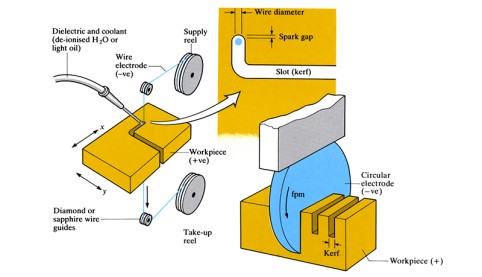 article icon
article icon
Science, Maths & Technology
Electrical Discharge Wire Cutting (EDWC) and Sawing (EDS)
In EDWC, sparks are generated between the electrically conductive material of the workpiece and a vertical cutting wire (the negative electrode that is constantly fed from a spool), debris is carried away by the dielectric liquid. Heat from the electrical discharge melts away material to form a slot (kerf). EDS is a similar process, but the ...
 article icon
article icon
Science, Maths & Technology
Electrical Discharge Machining (EDM) and Grinding (EDG)
A workpiece made of electrically conductive material and a shaped tool are immersed in a dielectric fluid. Rapid pulses of electricity pass through the tool (+ve electrode) and the negatively charged workpiece, leading to a spark discharge. Plasma forms and, along with the sparks, vaporises the workpiece material removing material ‘chips’, which...
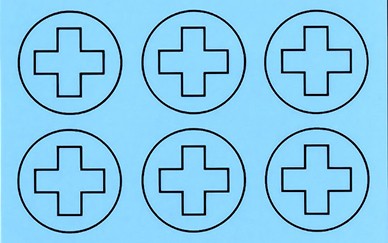 article icon
article icon
Science, Maths & Technology
Photochemical Machining (Photo-fabrication; Chemical milling)
A chemical etching process where material can be selectively removed from specific ‘unmasked’ areas of a pattern or image that was photographically reproduced onto the workpiece surface.
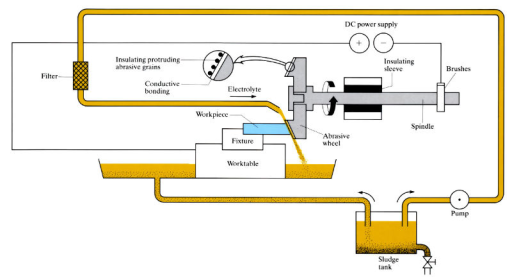 article icon
article icon
Science, Maths & Technology
Electrochemical Grinding (ECG)
An electrolyte is pumped into a small gap between the workpiece and a rotating abrasive grinding wheel. Metal is removed from the electrically conductive workpiece by electrochemical attack and abrasion. Protruding abrasive grit particles on the grinding wheel remove electrochemical oxidation from the surface of the workpiece.
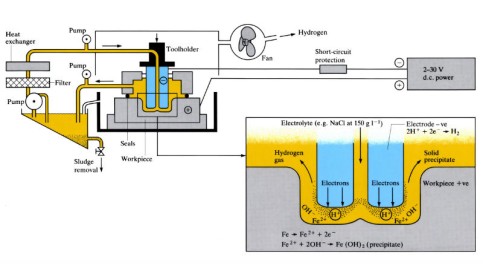 article icon
article icon
Science, Maths & Technology
Electrochemical Machining (ECM)
Works on the principle of anodic metal dissolution by electrical energy. An electrolyte medium separates the tool (cathode) from the electrically conductive metal workpiece (anode), creating an electrolytic cell. A high amperage, low voltage current is passed through the cell, selectively dissolving away the material to be removed. Produces ...
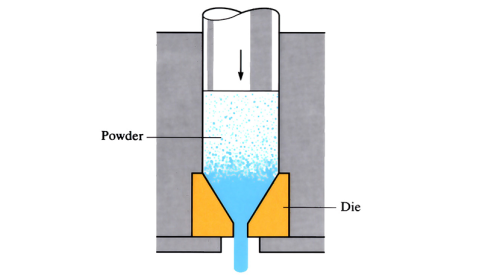 article icon
article icon
Science, Maths & Technology
Extrusion of Powders
Hydrostatic compressive stresses and shear forces act on the powders. In hot extrusion, powder mixture is pre-compacted (‘canned’) by heat compression until all air has been removed. The sealed can is then rammed by a punch, until it adopts the shape of the die. Compacting pressure causes long sections of material to extrude from a small opening...
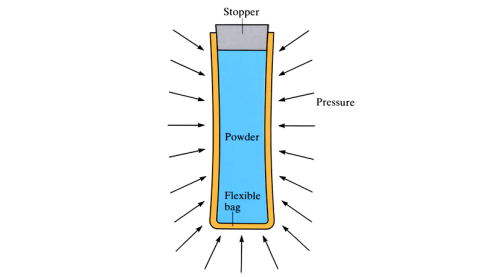 article icon
article icon
Science, Maths & Technology
Cold isostatic pressing
Material in powder form is sealed into a flexible mould (or bag) situated inside a pressure vessel. Hydrostatic pressure is applied to the outside of the mould, until the powder molecules inside have bonded sufficiently. Subsequent finishing processes may be required.
 article icon
article icon
Science, Maths & Technology
Finding creativity in orbit?
Has space tourist Trevor Beattie got it wrong by suggesting that it's time to send creative people to space?
 article icon
article icon
Science, Maths & Technology
Pressureless sintering
A process where loose metal powders are poured into a metal die and vibrated until loosely compacted. When filled, the die is placed inside a furnace and sintered.
 article icon
article icon
Science, Maths & Technology
Hot isostatic pressing (HIP)
High temperature and pressure are applied simultaneously to pre-cast or sintered components. The addition of argon gas to the furnace helps to apply isostatic pressure to the component/s. The pressure and heat help to fill any pores on the surface of the component, thus optimising material properties and density.
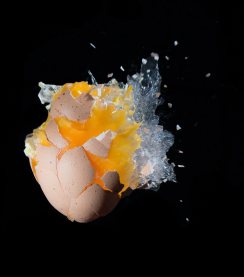 video icon
video icon
Science, Maths & Technology
What happens when you microwave an egg?
The New Scientist team have microwaved an egg, so you don't have to. Because you really, really shouldn't.
 article icon
article icon
Science, Maths & Technology
Download your free Matrix of Modern Life poster
A poster from The Open University that explores the colourful connections between different parts of science, engineering and technology - presented in the inimitable Bang style